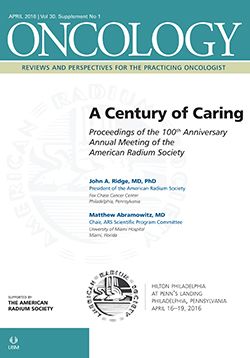(S019) Genomic Homogeneity of Lung and Liver Metastases of a Unique Primary in Individual Patients
In this first-of-its-kind analysis, assessing the radiosensitivity of multiple metastases from the same patient, we note a similar radiosensitivity fingerprint for lesions from the liver and lung from the same primary lesion.
Kamran A. Ahmed, MD, Peter A. Johnstone, MD, Steven A. Eschrich, PhD, Javier F. Torres-Roca, MD; H. Lee Moffitt Cancer Center and Research Institute
BACKGROUND: The radiosensitivity index (RSI) is a multigene expression model of tumor radiosensitivity that has been validated in multiple clinical cohorts. We have previously reported significant differences in RSI between colon cancer metastases based on anatomical location. Here, we report findings of multiple metastases of a unique primary to the lung and liver.
METHODS: In an institutional review board-approved study, the Moffitt Cancer Center Total Cancer Care biorepository was screened for metastatic lung and liver lesions from the same patient. Gene expression was assessed using Affymetrix Hu-RSTA-2a520709. The previously tested RSI 10-gene assay was run on tissue samples.
RESULTS: The median RSI for all liver lesions was 0.42 (quartile 1 [Q1], 0.31; quartile 3 [Q3], 0.49) vs 0.36 for lung lesions (Q1, 0.30; Q3, 0.47; P = .26); this is congruent with our prior published data. A total of 57 patients had multiple metastatic liver tissue samples (n = 123) available for analysis. Primary lesions included colorectal (89%, n = 110), breast (5%, n = 6), lung (3%, n = 4), and anal (2%, n = 3) tumors. The deviation from the mean for metastatic tumor samples from the same patient was 0.017 (Q1, 0.003; Q3, 0.035). A total of 30 patients had multiple metastatic lung tissue samples (n = 62). Primary lesions included colorectal (58%, n= 36), soft tissue (16%, n = 10), kidney (13%, n = 8), breast (6%, n = 4), and skin (6%, n = 4). The deviation from the mean for metastatic lung samples from the same patient was 0.023 (Q1, 0.0019; Q3, 0.059).
CONCLUSIONS: In this first-of-its-kind analysis, assessing the radiosensitivity of multiple metastases from the same patient, we note a similar radiosensitivity fingerprint for lesions from the liver and lung from the same primary lesion. This may be due to milieu-based selection of a unique metastatic clone or by re-metastasis of an existing metastatic lesion and warrants further experimental validation.
Proceedings of the 98th Annual Meeting of the American Radium Society - americanradiumsociety.org

Targeted Therapy First Strategy Reduces Need for Chemotherapy in Newly Diagnosed LBCL
December 7th 2025Lenalidomide, tafasitamab, rituximab, and acalabrutinib alone may allow 57% of patients with newly diagnosed LBCL to receive less than the standard number of chemotherapy cycles without compromising curative potential.